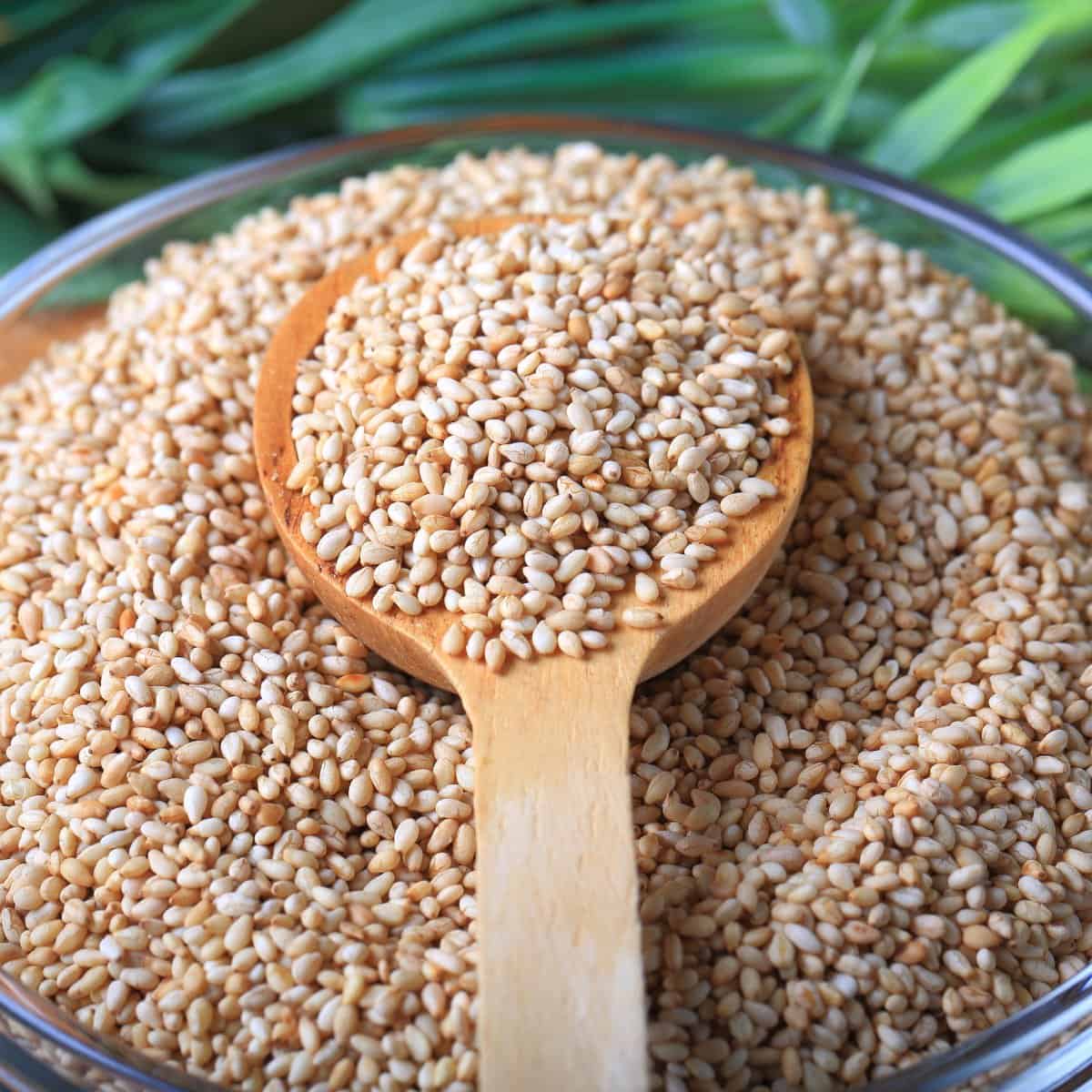How to Use Sesame Seeds in Cooking: Tips for Storage and Recipes
Sesame (Sesamum indicum) is a flowering plant in the genus Sesamum. Numerous wild relatives occur in Africa and a smaller number in India.
It is widely naturalized in tropical regions around the world and is cultivated for its edible seeds, which grow in pods.
Sesame seeds are a great way to add flavor to your cooking. They’re versatile and come in many different varieties. So let’s look at how to use them in cooking.


Check out our new cookbook
Bitemybun's family recipes with complete meal planner and recipe guide.
Try it out for free with Kindle Unlimited:
Read for freeIn this post we'll cover:
- 1 Get to Know Sesame Seeds: A Versatile Ingredient for Everyday Cooking
- 2 Get Toasted: How to Cook Sesame Seeds to Perfection
- 3 Storing Sesame Seeds: Keeping Them Fresh and Flavorful
- 4 Exploring the Delicious World of Asian Dishes with Sesame Seeds
- 5 The Nutritional Powerhouse: Health Benefits of Sesame Seeds
- 6 Conclusion
Get to Know Sesame Seeds: A Versatile Ingredient for Everyday Cooking
Sesame seeds are tiny, flat seeds that come from the sesame plant. They are available in two varieties: white and black. The white sesame seeds are more commonly used in cooking, while the black ones are mostly used for oil extraction. Sesame seeds have a nutty, slightly sweet flavor and are rich in oil, making them an essential ingredient in many cuisines around the world.
Using Sesame Seeds in Cooking
Sesame seeds are a versatile ingredient that can be used in a variety of dishes. Here are some ways to use sesame seeds in your cooking:
- Toasted sesame seeds: Toasted sesame seeds are a great way to add flavor and crunch to salads, stir-fries, and grilled vegetables. Simply toast the sesame seeds in a dry pan over medium heat until they are golden brown and fragrant.
- Sesame seed oil: Sesame seed oil is a flavorful and healthy oil that can be used for cooking, salad dressings, and marinades. It has a nutty flavor and is rich in antioxidants.
- Sesame seed mixture: A mixture of toasted sesame seeds, salt, and spices is a great seasoning for grilled meats, potatoes, and seafood. It adds a flavorful and slightly spicy kick to any dish.
- Sesame seed topping: Sprinkle toasted sesame seeds on top of boiled potatoes, baked chicken, or a fresh salad for added flavor and texture.
- Sesame seed sauce: Sesame seed sauce, also known as tahini, is a staple ingredient in Middle Eastern cuisine. It is made by blending toasted sesame seeds with olive oil, lemon juice, and garlic. It can be used as a dip for bread or vegetables, or as a sauce for grilled meats and fish.
- Sesame seed crusted treats: Sesame seeds can be used to coat and add flavor to fried or baked treats like Indian khoya, chikki, and bread. They can also be studded with other flavors like coriander, apple, or spiced yoghurt for added depth of flavor.
- Sesame seed in pulao: Sesame seeds can be added to rice dishes like pulao for added flavor and nutrition. They can be toasted or untoasted and mixed with other kinds of nuts and spices for a flavorful and healthy rice dish.
- Sesame seed wrapped seafood: Sesame seeds can be used to coat and add flavor to seafood like prawn, fish, and spinach. They can be marinated in a mixture of spices and then wrapped in sesame seeds for a flavorful and healthy lunch or dinner option.
Quality Check for Sesame Seeds
When buying sesame seeds, it’s important to check for quality. Here are some things to look for:
- Freshness: Sesame seeds should be fresh and free from any rancid or stale smell.
- Color: White sesame seeds should be uniform in color, while black sesame seeds should be shiny and uniform in size.
- Texture: Sesame seeds should be dry, crisp, and free from any moisture or mold.
Get Toasted: How to Cook Sesame Seeds to Perfection
Toasting sesame seeds on the stovetop is the best method for cooking them. It’s a quick and easy way to add a nutty flavor and a golden brown color to your food. Here’s how to do it:
- Place a small layer of sesame seeds in a dry skillet or pan.
- Heat the skillet over high heat, stirring the seeds constantly.
- Toast the seeds for 2-3 minutes or until they turn golden brown.
- Remove the skillet from heat and let the seeds cool.
Baking Method
Toasting sesame seeds in the oven is another great way to cook them. This method is perfect for cooking large quantities of sesame seeds at once. Here’s how to do it:
- Preheat the oven to 350°F (175°C).
- Spread the sesame seeds in a thin layer on a baking sheet.
- Bake the seeds for 5-10 minutes or until they turn golden brown.
- Remove the baking sheet from the oven and let the seeds cool.
Buying Sesame Seeds
When purchasing sesame seeds, it’s best to buy them in bulk at a grocery store or health food store. Middle Eastern stores are also a great place to purchase sesame seeds. Here are some tips to keep in mind:
- Look for seeds that are dry and free of moisture.
- Choose seeds that are uniform in color and size.
- Check the expiration date to ensure freshness.
Storing Sesame Seeds: Keeping Them Fresh and Flavorful
Storing sesame seeds properly is crucial to keep them fresh and flavorful. Improper storage can lead to rancidity, loss of flavor, and a shorter shelf life. Here’s why proper storage matters:
- Sesame seeds contain oils that can go rancid if not stored properly.
- The flavor of sesame seeds can deteriorate over time if not stored in the right conditions.
- Proper storage can extend the shelf life of sesame seeds and save you money in the long run.
How to Store Sesame Seeds
Here are some tips for storing sesame seeds to keep them fresh and flavorful:
- Store sesame seeds in an airtight container in a cool, dry place. A pantry or kitchen cabinet is a great place to store them.
- If you live in a hot and humid climate, consider storing sesame seeds in the refrigerator or freezer to extend their shelf life.
- Toasted sesame seeds can be stored in an airtight container at room temperature for up to a year.
- Raw sesame seeds should be stored in an airtight container in the refrigerator or freezer for up to six months.
- If you buy sesame seeds in bulk, transfer them to an airtight container as soon as possible to prevent them from going rancid.
- If you notice that your sesame seeds appear darker in color or have a rancid smell, it’s time to toss them out and buy a fresh batch.
How to Make Tahini
Tahini is a popular ingredient in Middle Eastern cuisine and is made from ground sesame seeds. Here’s how to make tahini:
- Toast sesame seeds in the oven following the instructions above.
- Allow the sesame seeds to cool completely.
- Pour the toasted sesame seeds into a food processor or blender and pulse until they form a thick, solid paste.
- Add a small amount of oil (such as olive oil) to the mixture and continue blending until the tahini reaches a smooth, pourable consistency.
- Store the tahini in an airtight container in the refrigerator for up to a month.
Exploring the Delicious World of Asian Dishes with Sesame Seeds
One of the most popular Asian dishes that use sesame seeds is grilled and marinated sesame chicken. This dish is easy to make and is perfect for those who love the unique nutty flavor of sesame seeds. To make this dish, you will need to marinate chicken pieces in a mixture of soy sauce, sesame oil, garlic, and ginger. Then, grill the chicken until it is cooked through and sprinkle sesame seeds on top for added flavor and crunch.
Sesame Seed Rice
Another delicious Asian dish that uses sesame seeds is sesame seed rice. This dish is a great vegetarian option and is perfect for those who are looking for a unique twist on traditional rice dishes. To make sesame seed rice, simply cook rice as you normally would and then add in sesame seeds and a bit of sesame oil for added flavor. This dish is perfect for serving with stir-fried vegetables or tofu.
Seafood with Sesame Sauce
Seafood with sesame sauce is another popular Asian dish that uses sesame seeds. This dish is perfect for seafood lovers and is a great way to add some heart-healthy goodness to your diet. To make this dish, you will need to cook your favorite seafood (such as shrimp or scallops) and then top it with a delicious sesame sauce made from sesame oil, soy sauce, and honey. Sprinkle sesame seeds on top for added flavor and crunch.
The Nutritional Powerhouse: Health Benefits of Sesame Seeds
Sesame seeds are a good source of protein, which is essential for maintaining and repairing tissues in our body. They contain all the essential amino acids, making them a complete protein source. Adding sesame seeds to your meals can help you meet your daily protein requirements.
Protect your heart
Sesame seeds contain unsaturated fats that help in keeping your heart healthy by replacing the saturated fats. They also contain sesamin and sesamolin, which are lignans that have been found to lower cholesterol levels. Consuming sesame seeds regularly can reduce the risk of coronary heart disease.
Essential vitamins and minerals
Sesame seeds are packed with essential vitamins and minerals that are beneficial for our body. They contain vitamin B, which helps in improving metabolism and maintaining healthy bones. They also provide a generous amount of magnesium, which is essential for muscle and nerve function.
Simple ways to add sesame seeds to your food
Sesame seeds can be used in a variety of ways in the kitchen. Here are some suggestions:
- Sprinkle sesame seeds generously on top of your homemade bread or mixed into your bread dough. Spelt flour and sesame seeds make a brilliant combination for bread and pretzels.
- Add a pack of goodness to your salad by tossing in some sesame seeds.
- Make a delicious and nutritious dressing by mixing sesame seed oil, soy sauce, and honey.
- Use sesame seed paste (tahini) as an ingredient in your hummus or as a spread on your toast.
- Finished off your Asian-inspired meals with a bright and tasty sesame seed sprinkle on top of your prawns or octopus.
Sesame seeds are a simple food that can help you maintain a healthy diet. They are high in protein, vitamins, and minerals, and can provide a range of health benefits. So start adding sesame seeds to your meals today and enjoy the extra sharp and delicious taste they bring.
Conclusion
So, there you have it- everything you need to know about using sesame seeds in cooking. They’re a great way to add some nutty flavor and a little bit of texture to your dishes, and they’re pretty healthy too! So don’t be afraid to give them a try!
Check out our new cookbook
Bitemybun's family recipes with complete meal planner and recipe guide.
Try it out for free with Kindle Unlimited:
Read for freeJoost Nusselder, the founder of Bite My Bun is a content marketer, dad and loves trying out new food with Japanese food at the heart of his passion, and together with his team he's been creating in-depth blog articles since 2016 to help loyal readers with recipes and cooking tips.
